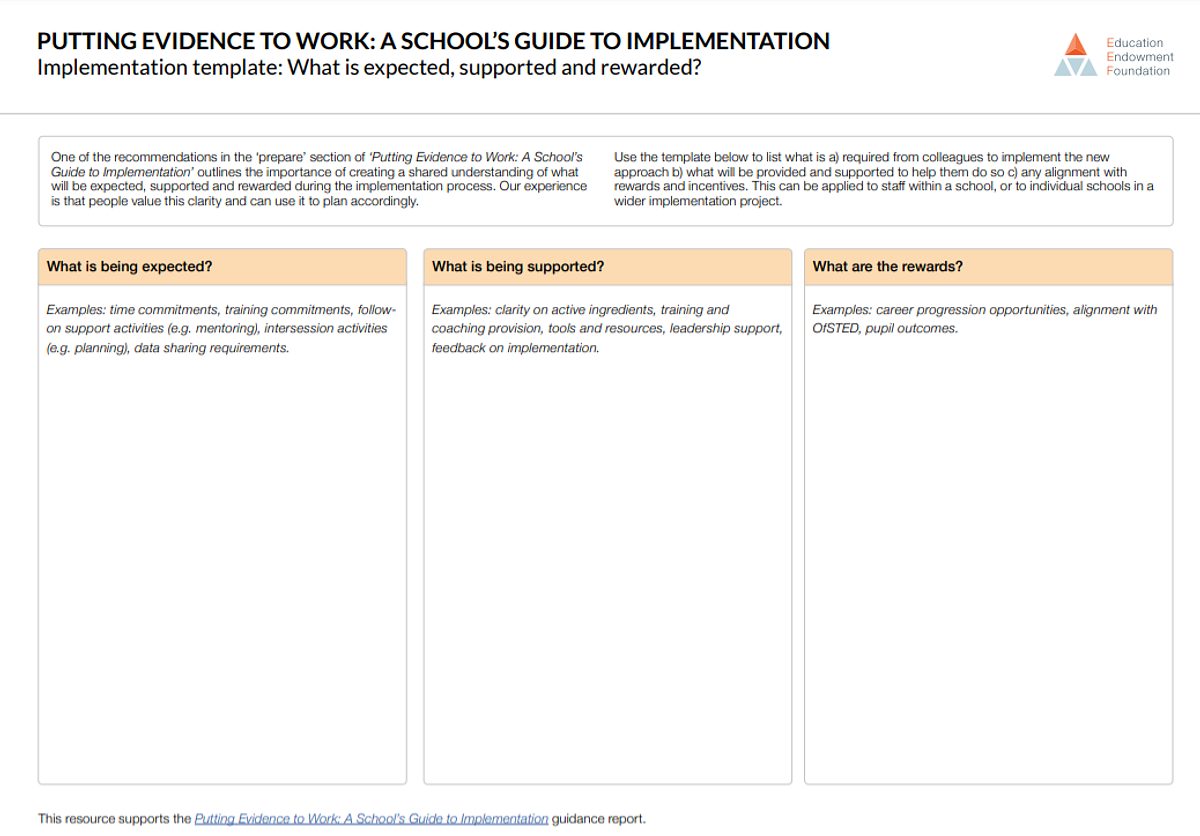
Blog -
Scaffolding to Support Working Memory Demands: Questions for Reflection
We share questions and resources to unpick the EEF’s Voices from the Classroom

Share on:

by Bradford Research School
on the
Mark Miller is Director of Bradford Research School
Mechanism 5 of the EEF’s Effective Professional Development guidance report is: Providing affirmation and reinforcement after progress, and it is part of the strand that focuses on how we motivate teachers to act upon knowledge gained in PD. Here are all 43 words of the entry:
Providing affirmation and reinforcement after a teacher has made an effort to alter practice—or shown progress in performing a new skill—may improve teachers’ motivation to act upon professional development. This should come after the change has been attempted (rather than before).
It’s a short entry because the message is pretty clear. But ensuring that it happens is not easy. To help, we can focus on a couple of ways to ensure that affirmation, reinforcement and praise happen as part of our PD programmes:
Part of the Process
We can consciously design our PD programmes to build in affirmation and reinforcement. For example, the first step of the Leverage Leadership instructional coaching model is to ‘provide precise praise.’ Precise praise will usually be based on agreed actions from previous coaching sessions, with an action step in place, so there is a likelihood that they will have been successful. And even if something is attempted unsuccessfuly, we can praise the action nonetheless.
By formalising praise as part of the process, is there a danger that it feels meaningless? – i.e. it’s the first step therefore it has to happen. This may be the case if PD is not well designed, or we are randomly looking for things to praise, but if we are affirming steps taken, progress made, and strategies actioned, it is not a box to tick, but a success to celebrate.
When implementation planning, and designing the professional development that might support, we can plan for the opportunities to provide affirmation as part of the process. As we wrote in this blog on Clarity for Implementation Communication, ‘leaders of implementation in schools should be pro-active in identifying behaviours that are conducive to good implementation, and celebrate them.’ The Expected, Supported, Rewarded template is useful when planning in advance.

If we are clear about what these successes look like, we can be proactive in identifying and celebrating them.
Part of the culture
In Practice Perfect, Lemow, Woolway and Yezzi write: ‘Organisations can support the effective use of praise in two vital ways: Normalising effective praise that encourages good practice; and second, through creating strong systems of recognition.’
A great example of a strong system of recognition is the Bright Spots approach that they use at Durrington High School. In this example, Metacognition Bright Spots, Chris Runeckles shares examples of great classroom practice in a blog. Here is an exytract:
However, what was particularly good was the questioning that followed. This was targeted at the different techniques students had used in attempting to memorise the answers. Rather than considering the task complete once students had finished the written element, Sam was building in structured reflection of the strategies students had used and their relative success. The discussion he elicited was really strong and was exemplary in terms of developing self-regulation in geography.
Capturing good examples of implementation is beneficial for a number of reasons. First, the individual praise motivates those teachers to continue with their practice. General praise may be nice, but this precise acknowledgement of successfully implementing an approach is much more meaningful. Furthermore, these examples serve as concrete examples of effective implementation. In a previous blog, Moving Forward With Metacognition, he acknowledges that ‘the implementation of metacognition as an intervention can be troublesome due to its nebulous nature.’ Because this is a well-established approach at Durrington, the mechanism is built in and part of the culture. (Read more examples of their Bright Spots here)
Not every school has a blog to post examples of great practice on, so we should consider what our own artefacts are. What approaches can we build in that allow for the affirmation and reinforcement of our professional development?
A final thought on this mechanism. In the accompanying systematic review document, they share this from Delin and Baumeister (1998). It’s a reminder that taking time to look for the successes and affirm them has many benefits:
Praise is an interpersonal communication in which one person expresses a positive evaluation of another person. The potential effects thus include cognitive responses, emotional responses, motivational responses, and interpersonal consequences.

Mechanism 1: Effective Professional Development: Managing Cognitive Load
Mechanism 2: Effective Professional Development: Revisiting Prior Learning
Mechanism 3: Next Goal Wins: Goal-setting in Professional Development
Mechanism 4: Research Says…
Mechanism 5: Praise in PD: Part of the Process; Part of the Culture
Mechanism 6: Professional Development: What Techniques and Why?
Mechanism 7: Professional Development: Practical Social Support
Mechanism 8: Modelling the technique
Mechanism 9: Providing Feedback
Mechanism 10: Rehearsing the Technique
Mechanism 11: Effective Professional Development: Prompts and Cues
Mechanism 12: Effective Professional Development: Action Planning
Mechanism 13: Effective Professional Development: Encouraging Self-monitoring
Mechanism 14: Effective Professional Development: Context Specific Repetition

Blog -
We share questions and resources to unpick the EEF’s Voices from the Classroom

Blog -
Investing in Subject Knowledge has Multiple Benefits

Blog -
Success is an important factor in motivation – how do we reconcile that with desirable difficulty?
This website collects a number of cookies from its users for improving your overall experience of the site.Read more